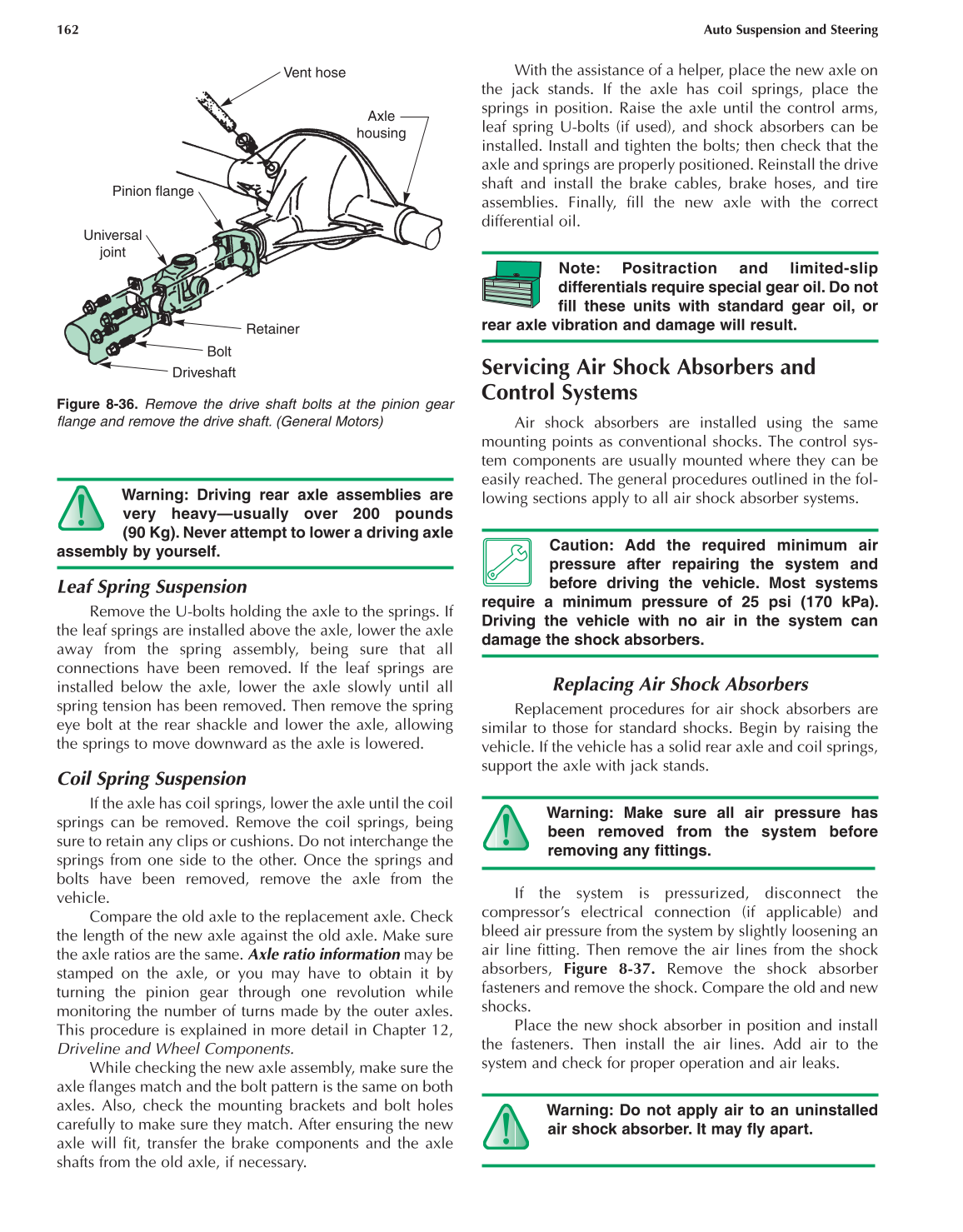162 Auto Suspension and Steering
Warning: Driving rear axle assemblies are
very heavy—usually over 200 pounds
(90 Kg). Never attempt to lower a driving axle
assembly by yourself.
Leaf Spring Suspension
Remove the U-bolts holding the axle to the springs. If
the leaf springs are installed above the axle, lower the axle
away from the spring assembly, being sure that all
connections have been removed. If the leaf springs are
installed below the axle, lower the axle slowly until all
spring tension has been removed. Then remove the spring
eye bolt at the rear shackle and lower the axle, allowing
the springs to move downward as the axle is lowered.
Coil Spring Suspension
If the axle has coil springs, lower the axle until the coil
springs can be removed. Remove the coil springs, being
sure to retain any clips or cushions. Do not interchange the
springs from one side to the other. Once the springs and
bolts have been removed, remove the axle from the
vehicle.
Compare the old axle to the replacement axle. Check
the length of the new axle against the old axle. Make sure
the axle ratios are the same. Axle ratio information may be
stamped on the axle, or you may have to obtain it by
turning the pinion gear through one revolution while
monitoring the number of turns made by the outer axles.
This procedure is explained in more detail in Chapter 12,
Driveline and Wheel Components.
While checking the new axle assembly, make sure the
axle flanges match and the bolt pattern is the same on both
axles. Also, check the mounting brackets and bolt holes
carefully to make sure they match. After ensuring the new
axle will fit, transfer the brake components and the axle
shafts from the old axle, if necessary.
With the assistance of a helper, place the new axle on
the jack stands. If the axle has coil springs, place the
springs in position. Raise the axle until the control arms,
leaf spring U-bolts (if used), and shock absorbers can be
installed. Install and tighten the bolts; then check that the
axle and springs are properly positioned. Reinstall the drive
shaft and install the brake cables, brake hoses, and tire
assemblies. Finally, fill the new axle with the correct
differential oil.
Note: Positraction and limited-slip
differentials require special gear oil. Do not
fill these units with standard gear oil, or
rear axle vibration and damage will result.
Servicing Air Shock Absorbers and
Control Systems
Air shock absorbers are installed using the same
mounting points as conventional shocks. The control sys-
tem components are usually mounted where they can be
easily reached. The general procedures outlined in the fol-
lowing sections apply to all air shock absorber systems.
Caution: Add the required minimum air
pressure after repairing the system and
before driving the vehicle. Most systems
require a minimum pressure of 25 psi (170 kPa).
Driving the vehicle with no air in the system can
damage the shock absorbers.
Replacing Air Shock Absorbers
Replacement procedures for air shock absorbers are
similar to those for standard shocks. Begin by raising the
vehicle. If the vehicle has a solid rear axle and coil springs,
support the axle with jack stands.
Warning: Make sure all air pressure has
been removed from the system before
removing any fittings.
If the system is pressurized, disconnect the
compressor’s electrical connection (if applicable) and
bleed air pressure from the system by slightly loosening an
air line fitting. Then remove the air lines from the shock
absorbers, Figure 8-37. Remove the shock absorber
fasteners and remove the shock. Compare the old and new
shocks.
Place the new shock absorber in position and install
the fasteners. Then install the air lines. Add air to the
system and check for proper operation and air leaks.
Warning: Do not apply air to an uninstalled
air shock absorber. It may fly apart.
Vent hose
Axle
housing
Retainer
Bolt
Driveshaft
Universal
joint
Pinion flange
Figure 8-36. Remove the drive shaft bolts at the pinion gear
flange and remove the drive shaft. (General Motors)
